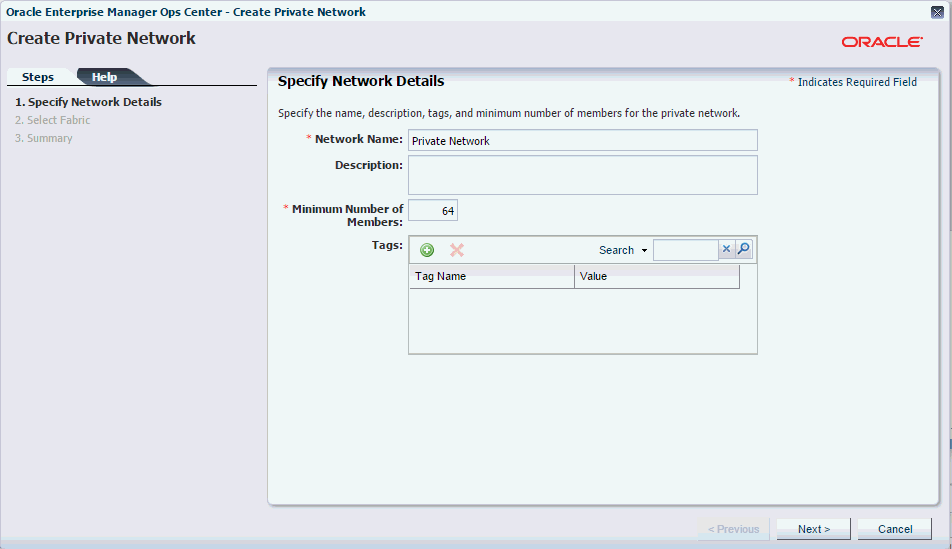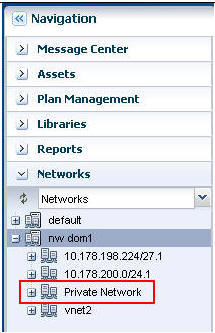Oracle® Enterprise Manager Ops Center
Create and Manage Private Networks
12c Release 3 (12.3.0.0.0)
E60044-01
June 2015
This guide provides an end-to-end example for how to use Oracle Enterprise Manager Ops Center.
Introduction
Oracle Enterprise Manager Ops Center provides comprehensive network management options that enable secure management of the virtual datacenter.
A private network is a network that uses private IP address space which follows the standards set by RFC 1918. You can use Oracle Enterprise Manager Ops Center to create private networks in a user-defined network domain when needed. The IP addresses are not globally delegated and not allocated to any specific organization; hence, any IP packets addressed by them cannot be transmitted onto the public Internet. You can use the private networks and assign them to assets when you want to isolate any application from the public network. You can create private networks only in a user-defined network domain.
A network domain is a logical grouping of related networking components in Oracle Enterprise Manager Ops Center. You can build networks on different types of fabrics such as fully managed, host-managed, or unmanaged. Private network creation is possible in fully managed and host-managed fabrics.
See Related Articles and Resources for links to related information and articles.
What You Will Need
You require the following to create private networks:
-
Network admin role to create private networks.
-
A user-defined network domain built on fully managed or host managed fabrics.
-
Network domain with VLAN IDs to be assigned to the private network.
Create a Private Network
You can create a private network using the following procedure when you select the user-defined network in the Network section. This option is not enabled if the network domain is built on unmanaged fabrics.
In this procedure, Oracle Enterprise Manager Ops Center creates a private network in the IP address range of 192.168.0.0 to 192.168.255.255, 172.16.0.0 to 172.16.255.255, 10.0.0.0 to 10.255.255.255. The IP address 192.168.0.0/24 is the address allocated to first network. Any free addresses from the ranges specified earlier is allocated based on the size and availability.
Perform the following steps to create a private network.
-
On the Navigation pane, under Networks, select a Network Domain. In this example, nw dom1 is selected.

Description of the illustration navig_network_domain.jpg
-
On the Actions pane, click Create Private Network.
-
In the Create Private Network wizard, enter the network details.

Description of the illustration specify_network_details.gif
-
In the Network Name field, enter a name for the network.
-
(Optional) In the Description field, enter a description.
-
In the Minimum Number of Members field, enter a value to specify the minimum number of virtual servers that can connect to the private network.
-
(Optional) Add tags for better identification and classification of the account.
-
Click Next.
-
-
Review the summary and click Finish.
The virtual private network is created and listed under Networks on the Navigation pane.

Description of the illustration network_created.jpg
What's Next?
The selected asset is assigned to a private network. You can run applications in isolation from the public network, thereby assuring secure management of assets.
Related Articles and Resources
The Oracle Enterprise Manager Ops Center 12c Release 3 documentation is available at http://docs.oracle.com/cd/E59957_01/index.htm.
See the following for more information:
-
For information about network resources and virtual datacenters, see the Oracle Enterprise Manager Virtualize Reference.
-
For information about networks, see the Oracle Enterprise Manager Configure Reference.
-
For a procedure for creating a network domain, see Create and Manage Network Domains.
For current discussions, see the product blog at https://blogs.oracle.com/opscenter.
See the Deploy How To library at http://docs.oracle.com/cd/E59957_01/nav/deploy.htm and the Operate How To library at http://docs.oracle.com/cd/E59957_01/nav/operate.htm for deployment and operational examples.
Documentation Accessibility
For information about Oracle's commitment to accessibility, visit the Oracle Accessibility Program website at http://www.oracle.com/pls/topic/lookup?ctx=acc&id=docacc.
Oracle customers that have purchased support have access to electronic support through My Oracle Support. For information, visit http://www.oracle.com/pls/topic/lookup?ctx=acc&id=info or visit http://www.oracle.com/pls/topic/lookup?ctx=acc&id=trs if you are hearing impaired.
Oracle Enterprise Manager Ops Center Create and Manage Private Networks, 12c Release 3 (12.3.0.0.0)
E60044-01
Copyright © 2007, 2015, Oracle and/or its affiliates. All rights reserved.
This software and related documentation are provided under a license agreement containing restrictions on use and disclosure and are protected by intellectual property laws. Except as expressly permitted in your license agreement or allowed by law, you may not use, copy, reproduce, translate, broadcast, modify, license, transmit, distribute, exhibit, perform, publish, or display any part, in any form, or by any means. Reverse engineering, disassembly, or decompilation of this software, unless required by law for interoperability, is prohibited.
The information contained herein is subject to change without notice and is not warranted to be error-free. If you find any errors, please report them to us in writing.
If this is software or related documentation that is delivered to the U.S. Government or anyone licensing it on behalf of the U.S. Government, then the following notice is applicable:
U.S. GOVERNMENT END USERS: Oracle programs, including any operating system, integrated software, any programs installed on the hardware, and/or documentation, delivered to U.S. Government end users are "commercial computer software" pursuant to the applicable Federal Acquisition Regulation and agency-specific supplemental regulations. As such, use, duplication, disclosure, modification, and adaptation of the programs, including any operating system, integrated software, any programs installed on the hardware, and/or documentation, shall be subject to license terms and license restrictions applicable to the programs. No other rights are granted to the U.S. Government.
This software or hardware is developed for general use in a variety of information management applications. It is not developed or intended for use in any inherently dangerous applications, including applications that may create a risk of personal injury. If you use this software or hardware in dangerous applications, then you shall be responsible to take all appropriate fail-safe, backup, redundancy, and other measures to ensure its safe use. Oracle Corporation and its affiliates disclaim any liability for any damages caused by use of this software or hardware in dangerous applications.
Oracle and Java are registered trademarks of Oracle and/or its affiliates. Other names may be trademarks of their respective owners.
Intel and Intel Xeon are trademarks or registered trademarks of Intel Corporation. All SPARC trademarks are used under license and are trademarks or registered trademarks of SPARC International, Inc. AMD, Opteron, the AMD logo, and the AMD Opteron logo are trademarks or registered trademarks of Advanced Micro Devices. UNIX is a registered trademark of The Open Group.
This software or hardware and documentation may provide access to or information about content, products, and services from third parties. Oracle Corporation and its affiliates are not responsible for and expressly disclaim all warranties of any kind with respect to third-party content, products, and services unless otherwise set forth in an applicable agreement between you and Oracle. Oracle Corporation and its affiliates will not be responsible for any loss, costs, or damages incurred due to your access to or use of third-party content, products, or services, except as set forth in an applicable agreement between you and Oracle.